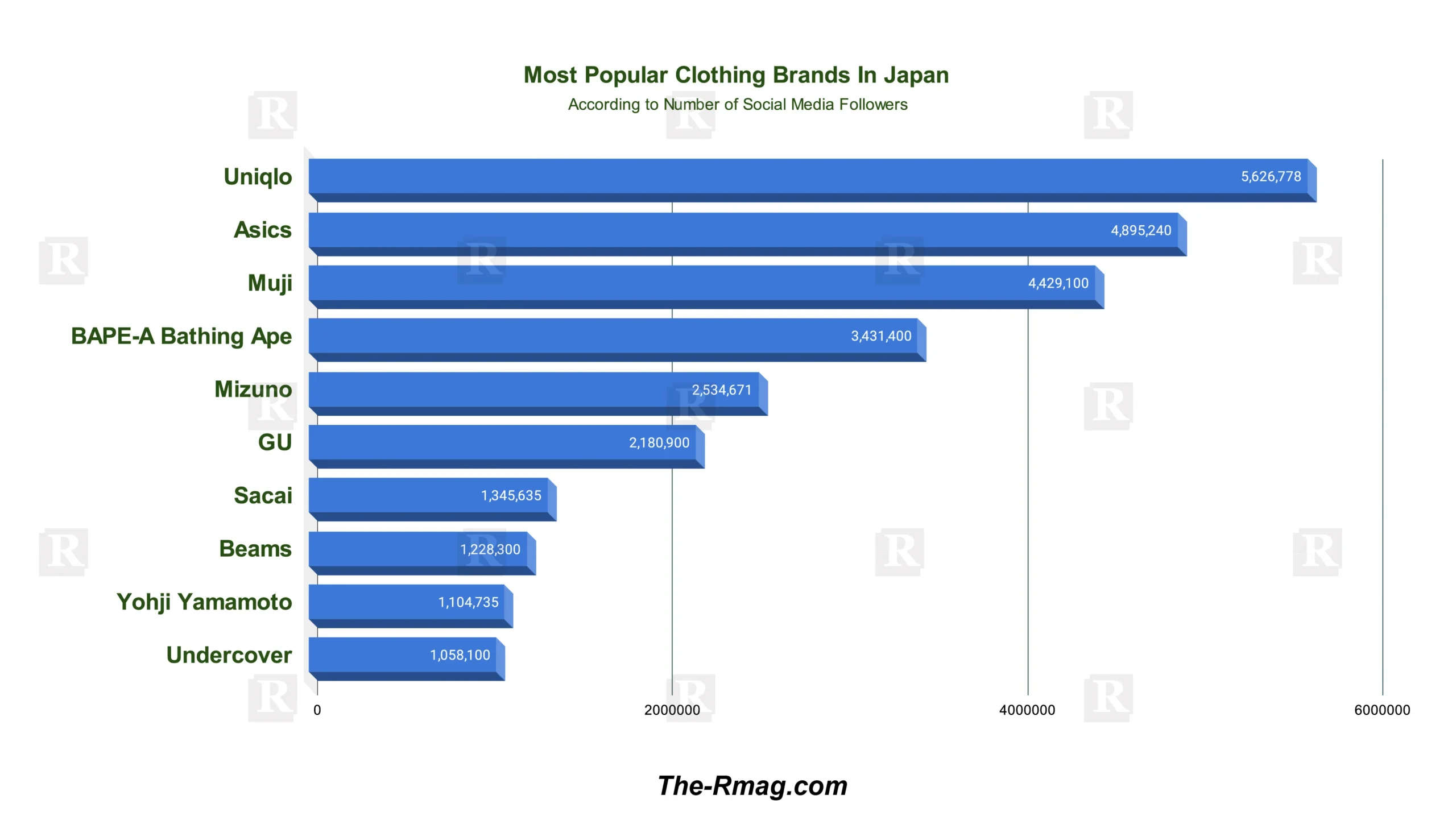
Japanese fashion has evolved into a global phenomenon, extending far beyond traditional garments like kimonos. The Land of the Rising Sun has become a trendsetter in the fashion industry, with its unique blend of tradition and modernity. In this exploration, we delve into the wardrobes of Japan, uncovering the stories behind the 10 most popular clothing brands in Japan that have not only shaped the nation’s style but have also left an indelible mark on the international fashion stage.
Table of Contents
Introduction
Japan’s fashion narrative is a captivating tale that weaves together centuries-old traditions with contemporary creativity. While traditional garments like kimonos showcase the country’s historical roots, the emergence of cutting-edge fashion brands signifies Japan’s role as a global fashion influencer. This exploration aims to shed light on the iconic Japanese brands that have transcended borders and captivated the world.
Uniqlo: The Casual Comfort
Year of Establishment: 1949
Key People: Tadashi Yanai (Founder)
Design Philosophy: Simplicity, Quality, Functionality
Headquarters: Tokyo, Japan
Annual Revenue: Approximately $22 billion
Founded in 1949, Uniqlo has become a global household name, synonymous with casual comfort and timeless style. The brand’s commitment to simplicity and quality has made it a staple in the wardrobes of millions.
Iconic products and design philosophy: Uniqlo’s innovative fabric technologies, such as Heattech and AIRism, have revolutionized the way we approach clothing. These technologies, designed for comfort and functionality, have become iconic, setting Uniqlo apart in the competitive fashion landscape.
Global impact and popularity: Uniqlo’s impact extends far beyond its Japanese origins. Collaborations with international designers, such as Jil Sander and Alexander Wang, have propelled Uniqlo into the global fashion spotlight. The brand’s popularity is a testament to its ability to offer affordable yet stylish clothing on a worldwide scale.
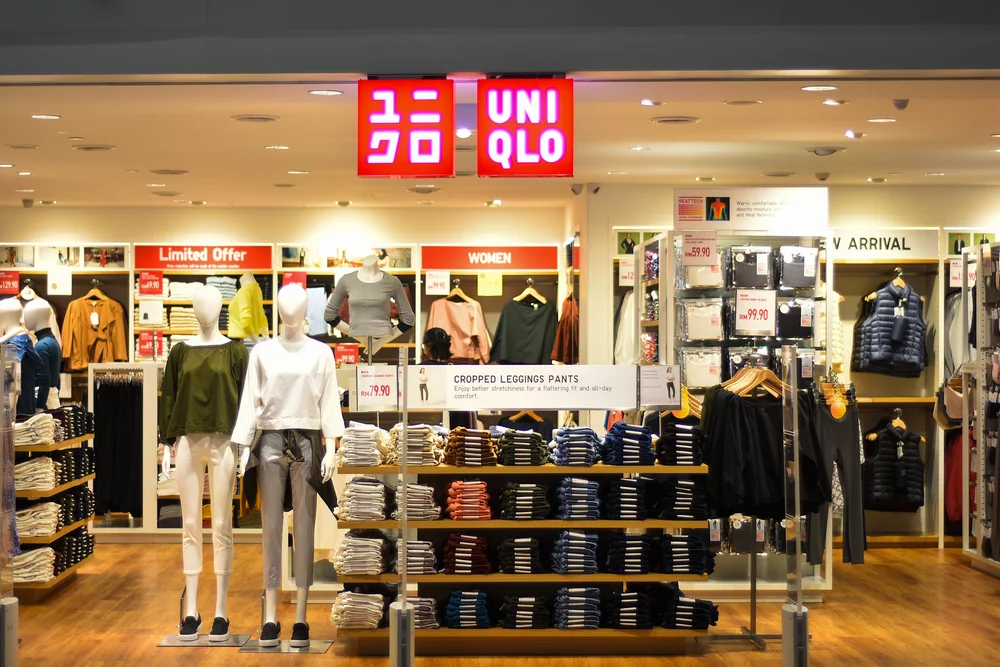
Photo/retailinasia
Asics: Blending Style and Performance
Year of Establishment: 1949
Key People: Kihachiro Onitsuka (Founder)
Design Philosophy: Fusion of Fashion and Functionality
Headquarters: Kobe, Japan
Annual Revenue: Approximately $3.8 billion
Asics, with its roots in athletic footwear and sportswear, stands out as a leading brand in the industry. The brand’s commitment to promoting a healthy lifestyle is embedded in its very name, “Anima Sana In Corpore Sano” (Healthy Soul In A Healthy Body).
Fusion of fashion and functionality: Asics goes beyond the conventional boundaries of sportswear, seamlessly blending style with performance. The incorporation of Gel technology in its footwear showcases the brand’s dedication to providing both fashion-forward and functional products.
Recognizable collaborations and endorsements: Collaborations with renowned fashion designers and endorsements by top athletes have solidified Asics’ status as a brand that caters to both the style-conscious and the performance-driven. These partnerships have not only elevated Asics within the fashion industry but have also broadened its appeal to a diverse audience.
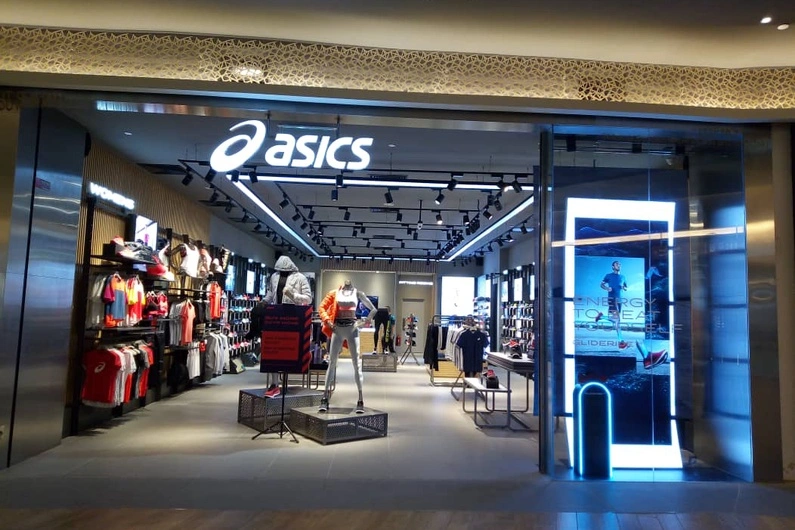
Photo/asics
Muji: Embracing Simplicity
Year of Establishment: 1980
Key People: Seiji Tsutsumi (Founder)
Design Philosophy: Simplicity, Quality, Sustainability
Headquarters: Tokyo, Japan
Annual Revenue: Approximately $3.3 billion
Muji, an abbreviation of Mujirushi Ryohin (No Brand, Quality Goods), has redefined minimalism in the fashion world. The brand’s minimalist approach to design extends beyond clothing, encompassing a wide range of products.
Diverse product range: Muji’s commitment to simplicity is evident in its diverse product range, covering everything from clothing to household items. The clothing line, characterized by clean lines and neutral colors, reflects Muji’s dedication to offering products that enhance everyday life.
Worldwide appeal and sustainable practices: Muji’s appeal goes beyond borders, attracting a global audience that appreciates the brand’s emphasis on simplicity and quality. Additionally, Muji’s dedication to sustainability, seen in its use of eco-friendly materials and minimalistic packaging, resonates with environmentally conscious consumers worldwide.
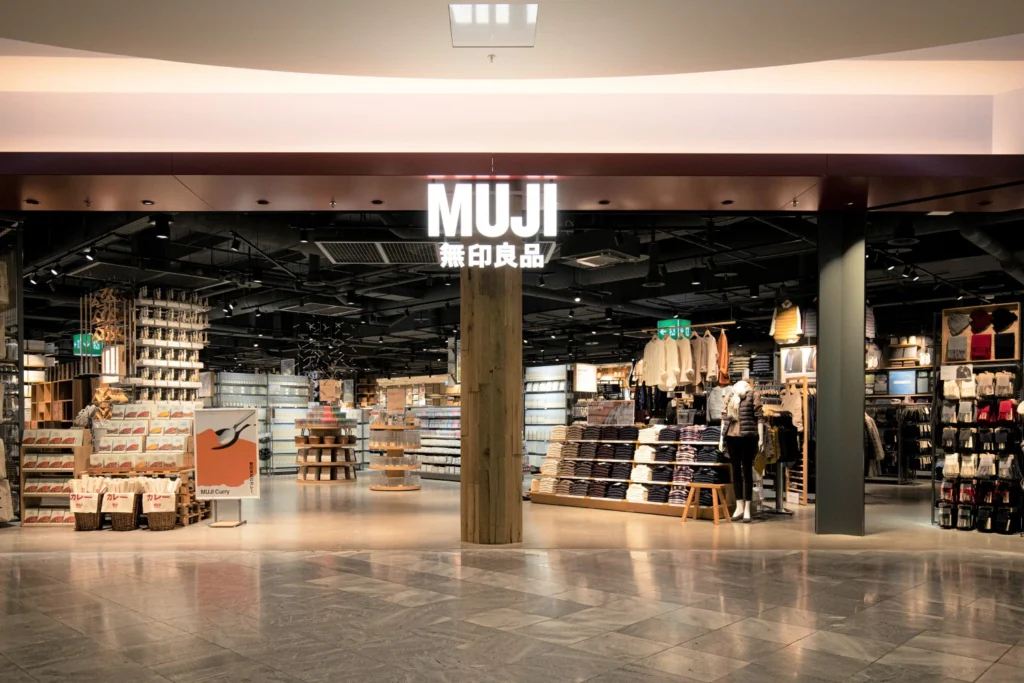
photo/muji
BAPE-A Bathing Ape: Streetwear Revolution
Year of Establishment: 1993
Key People: Nigo (Founder)
Design Philosophy: Bold, Unique, Streetwear
Headquarters: Tokyo, Japan
Annual Revenue: Approximately $200 million
BAPE, or A Bathing Ape, emerged as a revolutionary force in Japanese streetwear since its founding in 1993 by Nigo. The brand is renowned for its bold designs, unique patterns, and a distinctive camouflage motif.
Streetwear culture influence: BAPE played a pivotal role in shaping streetwear culture, not only in Japan but globally. Its distinctive aesthetic and limited edition releases have created a dedicated fan base, turning BAPE into a symbol of street fashion luxury.
Limited edition releases and collaborations: The concept of limited edition releases has become synonymous with BAPE, adding an element of exclusivity to its products. Collaborations with major brands and influential personalities, including collaborations with Kanye West and Pharrell Williams, have further elevated BAPE’s status in the fashion world.
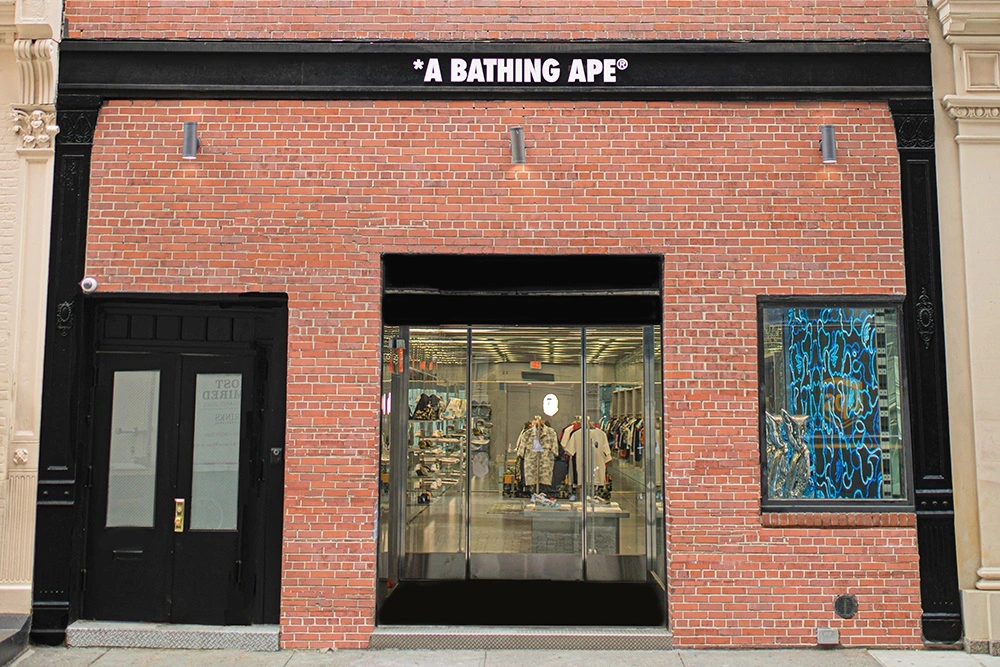
photo/bape
Mizuno: A Heritage in Sportswear
Year of Establishment: 1906
Key People: Rihachi Mizuno (Founder)
Design Philosophy: Performance, Innovation, Quality
Headquarters: Osaka, Japan
Annual Revenue: Approximately $2 billion
With a history dating back to 1906, Mizuno has established itself as a heritage brand in athletic footwear and apparel. The brand’s commitment to quality and innovation has made it a trusted choice for athletes worldwide.
Technological innovations: Mizuno’s sportswear incorporates cutting-edge technologies to enhance performance and comfort. The introduction of the Wave technology in running shoes, for example, showcases Mizuno’s dedication to pushing the boundaries of athletic wear.
Global recognition in sports: Mizuno’s presence in various sports, from running to golf, has earned it global recognition. The brand’s partnerships with athletes and teams contribute to its standing as a symbol of excellence in sports fashion.
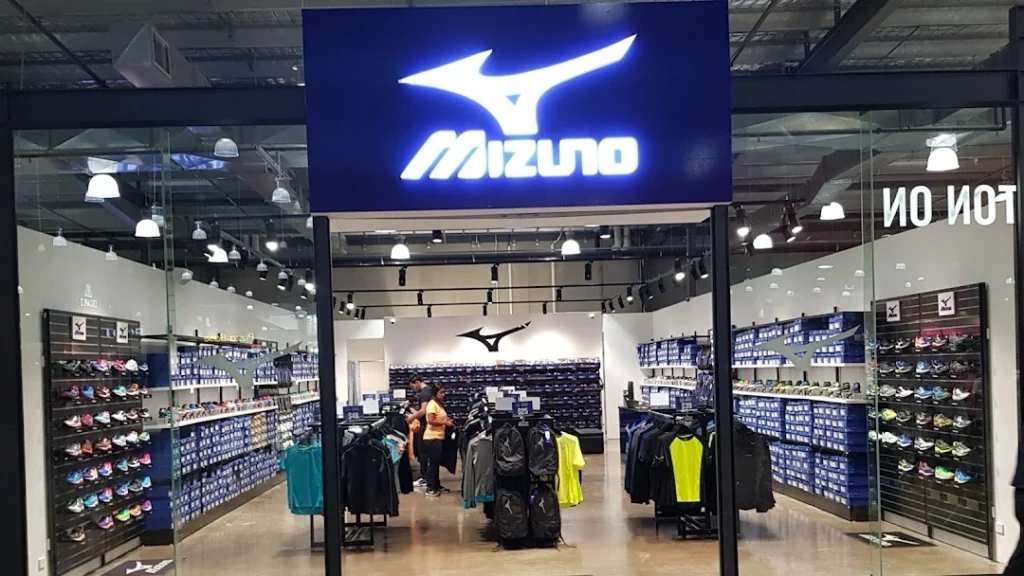
Photo/mizuno
GU: Affordable Fashion for All
Year of Establishment: 2006
Key People: Tadashi Yanai (Founder, Fast Retailing)
Design Philosophy: Trendy, Affordable, Inclusive
Headquarters: Tokyo, Japan
Annual Revenue: Approximately $2.5 billion (as of 2022)
GU, a subsidiary of Fast Retailing (parent company of Uniqlo), distinguishes itself by offering trendy and affordable fashion. The brand aims to make fashion accessible to a wide audience without compromising on style.
Trendy designs and inclusivity: GU’s clothing appeals to a broad demographic, with trendy designs for men, women, and children. The brand’s commitment to inclusivity is reflected in its diverse product range, ensuring that fashion is for everyone.
Expansion and popularity: GU’s popularity extends beyond Japan, with an expanding international presence. The brand’s ability to stay on-trend while maintaining affordability has contributed to its success, making it a go-to choice for fashion-conscious individuals worldwide.
Sacai: Bridging High Fashion and Casual
Year of Establishment: 1999
Key People: Chitose Abe (Founder)
Design Philosophy: Avant-Garde, Innovative, Wearable
Headquarters: Tokyo, Japan
Sacai, founded by Chitose Abe, is celebrated for its avant-garde approach to design. The brand seamlessly bridges the gap between high fashion and casual wear, creating pieces that are both innovative and wearable.
Collaboration with major brands: Sacai’s collaborations with major brands, such as Nike and The North Face, showcase its ability to blend high-end fashion with streetwear. These partnerships have garnered attention, solidifying Sacai’s position as a brand at the intersection of luxury and casual style.
Recognition in the fashion industry: Sacai’s innovative designs have earned recognition within the fashion industry. The brand’s presence at international fashion events and collaborations with renowned designers highlight its influence and contribution to pushing the boundaries of conventional fashion.
Beams: A Lifestyle Brand
Year of Establishment: 1976
Key People: Yo Shitara (Founder)
Design Philosophy: Lifestyle, Versatility, Contemporary
Headquarters: Tokyo, Japan
Founded in 1976, Beams transcends the definition of a mere clothing brand—it is a lifestyle. The brand’s diverse product range includes not only clothing but also accessories and home goods.
Influence on Japanese lifestyle: Beams has played a significant role in shaping the modern Japanese lifestyle. The brand’s keen understanding of contemporary trends and consumer preferences is evident in its curated product selection, which reflects the evolving tastes of the Japanese population.
International expansion and collaborations: Beams’ influence extends globally through collaborations with international brands. The brand’s ability to adapt while maintaining its Japanese identity has contributed to its success on the global stage, making Beams a cultural ambassador for Japanese lifestyle and fashion.
Yohji Yamamoto: Avant-Garde Fashion Icon
Year of Establishment: 1981
Key People: Yohji Yamamoto (Founder)
Design Philosophy: Avant-Garde, Oversized, Challenging Norms
Headquarters: Tokyo, Japan
Yohji Yamamoto, a trailblazer in the fashion industry since the 1980s, is renowned for his avant-garde and oversized designs. His unique approach to fashion challenges traditional norms and has left an indelible mark on the industry.
Impact on global fashion: Yohji Yamamoto’s impact on global fashion is immeasurable. His avant-garde designs have influenced a generation of designers worldwide, challenging the conventional definitions of beauty and style.
Collaboration with Adidas and Y-3 line: The collaboration between Yohji Yamamoto and Adidas resulted in the Y-3 line, a fusion of avant-garde fashion and sportswear. This partnership has been influential in bridging the gap between high fashion and athletic wear, showcasing Yohji Yamamoto’s versatility and impact beyond traditional runway shows.
Undercover: Pushing Fashion Boundaries
Year of Establishment: 1993
Key People: Jun Takahashi (Founder)
Design Philosophy: Experimental, Artistic, Dark Aesthetic
Headquarters: Tokyo, Japan
Founded by Jun Takahashi, Undercover is synonymous with an experimental and often dark aesthetic. The brand pushes the boundaries of conventional fashion, challenging norms with each collection.
Noteworthy collections and themes: Undercover’s collections are known for their thought-provoking themes, ranging from punk influences to literary references. Each collection tells a unique story, making Undercover a brand for those seeking more than just clothing—it’s an exploration of art and expression.
Recognition in the fashion avant-garde: Undercover’s presence in the fashion avant-garde has solidified its status as a brand that transcends traditional norms. Its runway shows, often theatrical in nature, and collaborations with artists showcase a commitment to artistic expression that goes beyond conventional fashion expectations.
Exploring the Japanese Fashion Landscape
Diversity and innovation: The Japanese fashion landscape is a canvas painted with diversity and innovation. From traditional garments that celebrate the country’s rich cultural heritage to avant-garde designs that push the boundaries of fashion, Japan offers a dynamic range of styles that cater to every taste.
Cultural influences on fashion: Japanese fashion draws inspiration from its rich cultural tapestry. Traditional motifs, fabrics, and craftsmanship often find their way into contemporary designs, creating a unique fusion of the old and the new. This cultural influence resonates not only within Japan but also on the global fashion stage.
Global impact of Japanese clothing brands: The global impact of Japanese clothing brands extends beyond the realm of fashion. These brands serve as cultural ambassadors, introducing the world to the unique blend of tradition and modernity that defines Japanese aesthetics. From Tokyo to New York, Japanese fashion is embraced and celebrated for its innovation and individuality.
Most Popular Clothing Brands In Japan at a Glance:
Below is a table summarizing the information for each of the 10 most popular clothing brands in Japan:
| Brand | Year of Establishment | Key People | Design Philosophy | Headquarters |
|---|---|---|---|---|
| Uniqlo | 1949 | Tadashi Yanai | Simplicity, Quality, Functionality | Tokyo, Japan |
| Asics | 1949 | Kihachiro Onitsuka | Fusion of Fashion and Functionality | Kobe, Japan |
| Muji | 1980 | Seiji Tsutsumi | Simplicity, Functionality, Quality | Shibuya, Tokyo, Japan |
| BAPE-A Bathing Ape | 1993 | Nigo | Bold Designs, Unique Patterns, Streetwear Culture | Tokyo, Japan |
| Mizuno | 1906 | Rihachi Mizuno | Technological Innovation, Performance Enhancement | Osaka, Japan |
| GU | 2006 | Tadashi Yanai | Trendy Designs, Affordability, Inclusivity | Tokyo, Japan |
| Sacai | 1999 | Chitose Abe | Avant-Garde, Bridging High Fashion and Casual | Tokyo, Japan |
| Beams | 1976 | – | Lifestyle Brand, Versatile Product Range | Tokyo, Japan |
| Yohji Yamamoto | 1981 | Yohji Yamamoto | Avant-Garde Style | Tokyo, Japan |
| Undercover | 1993 | Jun Takahashi | Experimental, Pushing Fashion Boundaries | Tokyo, Japan |
Also Read-From Bazaars to Boutiques: 10 Most Popular Clothing Brands in Turkey
Conclusion
In conclusion, our journey through the 10 most popular clothing brands in Japan unveils a dynamic and diverse fashion landscape. Each brand, from the casual comfort of Uniqlo to the avant-garde designs of Undercover, contributes to the global fashion narrative in its own unique way. Japan’s influence on the fashion industry is not confined to traditional garments; it extends to innovative designs that resonate with audiences worldwide. As we celebrate these brands, we celebrate the fusion of tradition and modernity that defines Japanese fashion.
FAQs
A. Are these brands available outside of Japan?
Yes, many of these brands have expanded globally, making their products accessible to an international audience.
B. How do Japanese clothing brands influence global fashion trends?
Japanese clothing brands influence global fashion trends by introducing unique designs, innovative technologies, and a blend of traditional and modern elements.
C. What sets Japanese streetwear apart from other styles?
Japanese streetwear is characterized by its bold designs, attention to detail, and a fusion of street culture with high-end fashion, setting it apart from other styles.
D. Are these brands sustainable?
Some Japanese brands, like Muji, have a strong focus on sustainability, using eco-friendly materials and adopting environmentally conscious practices.
E. How has Japanese fashion evolved over the years?
Japanese fashion has evolved by embracing a mix of traditional and contemporary styles, experimenting with avant-garde designs, and becoming a global trendsetter.
F. What are the most popular clothing brands in Japan?
Uniqlo, Asics, Muji, BAPE-A Bathing Ape, Mizuno, GU, Sacai, Beams, Yohji Yamamoto, Undercover -these are the most popular clothing brands in Japan.
There is definately a lot to find out about this subject. I like all the points you made